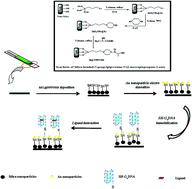A human telomeric G-quadruplex-based electronic nanoswitch for the detection of anticancer drugs†
Abstract
An electronic nanoswitch is described based on the conformational change of the DNA sequence in the presence of stabilizing ligands. The new electrochemical biosensor was prepared by modifying a screen-printed graphite electrode (SPE) with functionalized SiO2 nanoparticles [(SiO2-N-propylpiperazine-N-(2-mercaptopropane-1-one) (SiO2@NPPNSH)] and Au nanoparticles (AuNPs). These nanoparticles are able to immobilize thiolated G-quadruplex DNA structures (SH-G4DNA). The SH groups on the SiO2@NPPNSH nanoparticles provide a good platform for stabilizing AuNPs on the surface of the electrode. This is due to the fact that AuNPs are able to bind to the organic SH groups on the SiO2@NPPNSH. The SH-G4DNA binds to the modified electrode by a AuNPs–S bond. The structure of SiO2@NPPNSH was characterized by scanning electron microscopy (SEM), thermo-gravimetric analysis (TGA) and infrared (IR) spectroscopy. The morphology of the modified electrode was characterized by SEM. The interaction between G4DNA and the anticancer drug, Tamoxifen (Tam), was studied in Tris–HCl buffer and [Fe(CN)6]3− using cyclic (CV) and square wave voltammetry (SWV). The G-quadruplex formation and the interaction mechanism were identified by circular dichroism (CD) measurements. The CV current was seen to decrease with increasing concentration of Tam due to interaction between G4DNA and Tam. This biosensor is a simple and useful tool for selecting G-quadruplex-binding ligands.


 Please wait while we load your content...
Please wait while we load your content...